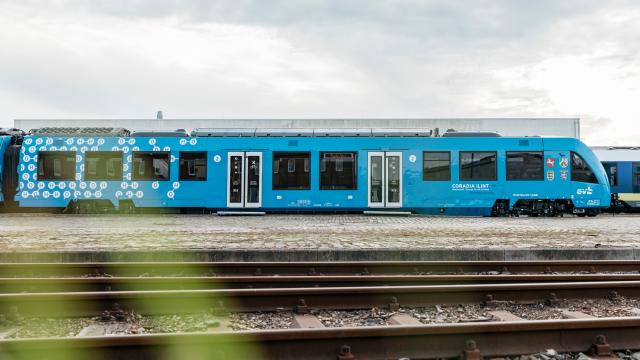It’s the kind of cross-cultural technical advancement that a utopian world could only dream of. Last weekend, French train-building company Alstom delivered its first two hydrogen-powered trains to Germany—the first of their kind but the first of many more Alstom is already contracted to build.
As reported by Ars Technica, hydrogen trains are slated to begin phasing out diesel trains. It’s the first step in an attempt to lower Germany’s transportation-related emissions by focusing instead on renewable energy. We’ve already had that whole Dieselgate scandal—this is a way for the country to find better ways to solve some problems.
Everyone these days seems to be focusing on electric technology. Why not opt for an electric train as opposed to a hydrogen one?
Refuelling a hydrogen fuel cell is a lot like filling up your regular ol’ gas tank. You can just pop some gas in and go. The ability to quickly and efficiently refuel is pretty important, since these trains are going to be used on a 100km stretch of track. For long-distance trips like that, the batteries on electric trains would have to sit and charge overnight, which kind of eliminates that whole “efficiency” thing.
Electric batteries are also, uh, really heavy. Electric trains do exist, but they’re the ones connected to an overhead line that electrifies the cab, which then supplies energy to the rest of the car. Great for cities. Not great for long hauls through the German countryside.
Hydrogen comes with its own unique set of challenges, though. Trying to store hydrogen is, frankly, a stupidly difficult task, and you also can’t just use it immediately to provide power. You have to go through a whole process to create fuel. In order to make it truly renewable and truly zero-emissions, you have to perform water electrolysis, which is just a fancy way of saying you split up the hydrogen and oxygen atoms of water with electricity.
If you’re thinking that sounds awfully scientific, you’re right. It’s more common to create hydrogen fuel through natural gas reforming. You basically get methane gas really hot, and the hydrogen separates out from it. As with most things that involve getting gas really really hot, this isn’t a fully zero-emissions process.
Alstom’s press release doesn’t get into the nitty-gritty of how they’re making their hydrogen, but it does note that the gas will be pumped into the trains via a 40 ft high steel container next to the tracks at Bremervörde. Alstom is going to produce fourteen more trains before 2021, so they’re also planning on building a stationary filling station to service all those trains.
The hydrogen trains have a pretty good range, too. Each one can travel 999km without needing to be refueled, which means they’d have to fill up once in the morning and then could travel the rest of the day without a hitch. And with a top speed of 140km/h, these bad boys can really cruise.
Another pro about hydrogen-powered trains is that they’re much quieter than their diesel counterparts, thus reducing noise pollution as well as carbon emissions. Any excess energy is stored in an electric battery that can then be used to power the hydrogen process on other trains.
It’s going to be an expensive project. The fourteen extra trains cost Germany $US94.5 million—and that’s not considering maintenance or the cost of running something so different than the rest of the world. But I’m sure the rest of the world is keeping an eye on things to see if this is a viable option for the future.
